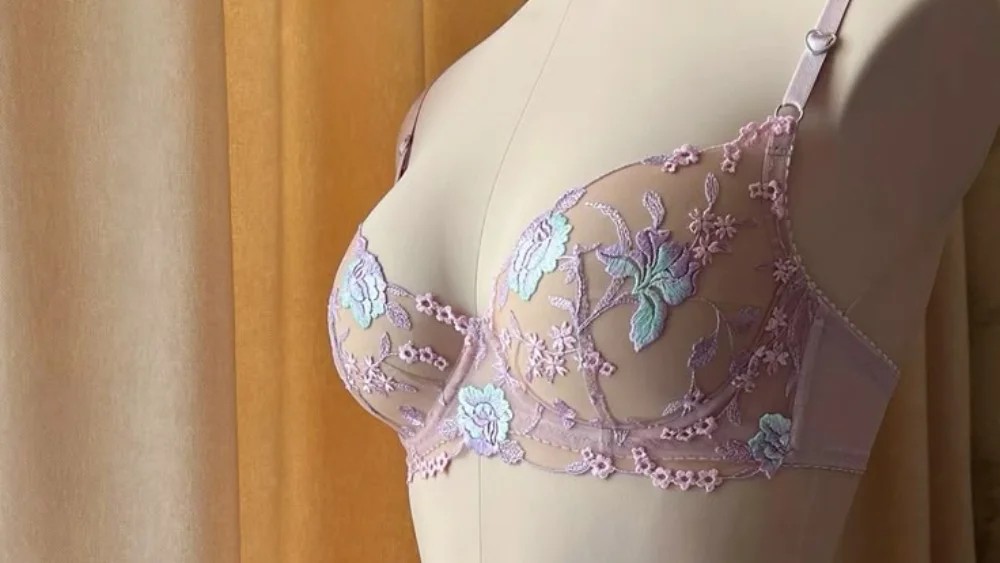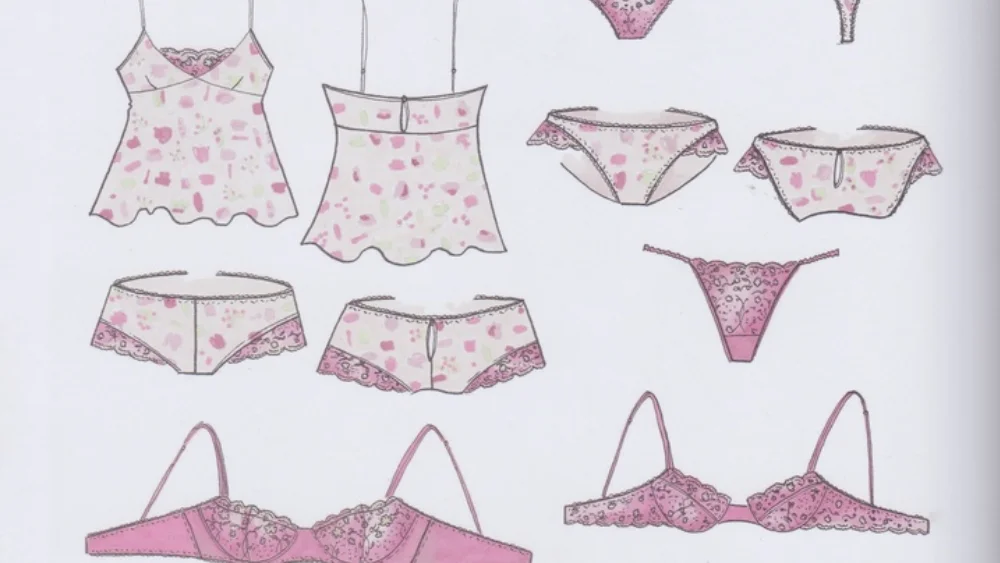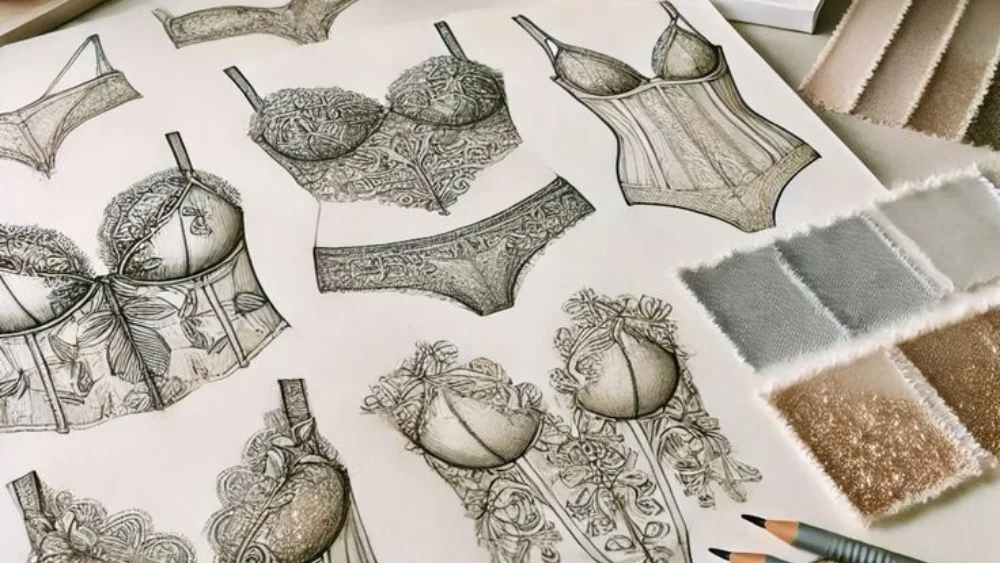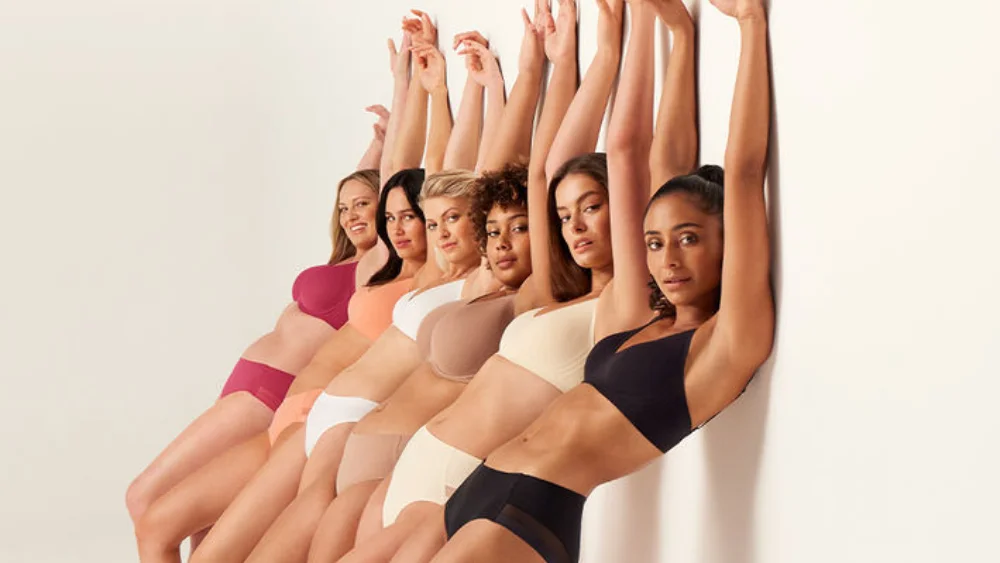In the competitive lingerie market, precision design is crucial for attract lingerie target customers. From fabric selection to market-driven insights, brands must balance aesthetics, comfort, and function to create lasting connections. This article explores strategies to optimize design, enhance customer loyalty, and ensure long-term success through data-driven decision-making.
Table of Contents
Thoughtful Design: The Key to Capturing Target Customers
In today’s highly competitive lingerie market, every design is vying for consumers’ attention. From classic lace bras to minimalist seamless lingerie, brands are striving to carve out a unique identity to win customer loyalty. However, precise design is not just about following fashion trends; it is an art that requires brands to deeply understand and meet the actual needs of their target customers. It not only drives sales but also determines whether a brand can stand out in an increasingly saturated market.
Consumer preferences are never static; they evolve with time, culture, and lifestyle changes. From Gen Z’s pursuit of personalization to Millennials’ enthusiasm for sustainable fabrics, and mature women’s preference for comfort and functionality, every generation is shaping the transformation of the lingerie industry. A brand’s ability to accurately capture these demands and translate them into unique and appealing designs directly impacts its market share and brand influence.
More importantly, precise design not only boosts sales but also cultivates customer loyalty. A lingerie piece that truly aligns with consumer needs becomes an integral part of their daily lives—whether it’s a wire-free bra that supports them through busy routines or a couture piece that enhances their silhouette. A well-designed product fosters emotional resonance with its wearer, strengthening their connection with the brand over time.
Therefore, this article will delve into how brands can attract lingerie target customers through precise design, covering everything from market insights and design strategies to brand marketing. By making design the core of their business, brands can establish a strong presence in the lingerie industry and effectively attract lingerie target customers, ensuring lasting growth and success.
Understanding the Target Market: Who Is Your Ideal Customer?

Different Ages, Different Needs: The Impact of Demographics
Lingerie is more than just clothing; it is an intimate part of a woman’s daily life, conforming to her body while fulfilling different needs and emotions at various life stages. Younger women, particularly Gen Z consumers, gravitate toward personalized, fashion-forward designs—bold colors, wire-free comfort, and even lingerie that doubles as outerwear. They seek self-expression through their lingerie choices and prioritize brands that embrace inclusivity and diversity.
For professional women over 30, quality, comfort, and functionality become the most crucial factors. Breathable fabrics, stable support, and adjustable designs are the key elements that truly win them over. Income level also plays a role in purchasing decisions—luxury consumers favor customization and exclusivity, while mainstream buyers focus on affordability and durability. Understanding these demographics helps brands create designs that effectively attract lingerie target customers across different market segments.
Psychological Traits: How Values Influence Design Choices
Modern women’s purchasing decisions are no longer solely based on physical needs but are increasingly influenced by values, lifestyles, and cultural perspectives. Millennials lean toward sustainable products, willing to invest in eco-friendly materials and multifunctional designs. In contrast, Gen Z prioritizes brands that advocate for female empowerment and body diversity.
Minimalists prefer seamless, wire-free designs for an effortless look, while active women seek technologically advanced, high-support sports lingerie. Brands that recognize these psychological needs and integrate them into their designs will not only create desirable products but also foster long-term emotional connections with their customers.
Cultural and Regional Differences: Western vs. Asian Markets
Cultural background plays a significant role in lingerie preferences. Western markets favor bold, sensual lingerie styles with lace, mesh, and deep V-cuts, emphasizing an aesthetic that complements outerwear. In contrast, Asian markets tend to embrace minimalist, functionality-driven designs, such as lightweight, breathable, and wire-free bras.
In countries like Japan and South Korea, lingerie that enhances a natural silhouette is highly preferred, whereas in Western markets, shaping and lift-enhancing designs still dominate. For brands looking to expand globally, understanding the local aesthetic preferences and wearing habits is essential to creating designs that truly attract lingerie target customers in different regions.
The Rise of the Plus-Size Market: Opportunities in Inclusive Design
For years, the lingerie industry largely overlooked plus-size consumers, but today, inclusive design has become a defining trend, with the plus-size market experiencing rapid growth. More than half of women worldwide wear plus-size lingerie, yet their needs remain underrepresented.
These consumers seek lingerie that is both sexy and comfortable, offering ample support without compromising on style. True inclusivity goes beyond simply offering larger sizes—it means respecting diverse body shapes, creating tailored designs that enhance comfort and confidence for all women.
Design Elements: How to Create the Most Appealing Products

Lingerie is more than just clothing—it is a form of self-expression, an attitude, and even an intimate conversation with oneself. To truly attract lingerie target customers, a design must go beyond fleeting fashion trends and strike the perfect balance between fabric, comfort, functionality, and aesthetics. It must also cater to the unique needs of different age groups, ensuring that every woman finds a piece that speaks to her. But how can lingerie design—from material selection to style—truly captivate consumers?
Fabric Choices: The Dual Consideration of Sustainability and Comfort
Fabric is the soul of lingerie. It directly affects the wearing experience and conveys a brand’s values. In today’s market, sustainable fabrics have become a crucial factor in defining a brand’s forward-thinking approach. Consumers increasingly seek lingerie that not only offers comfort but also minimizes environmental impact. Therefore, fabric selection must consider both traditional comfort and eco-friendly attributes:
- Organic Cotton: Soft, breathable, and free from chemical residues, making it ideal for sensitive skin.
- Recycled Fabrics: Made from repurposed fibers such as recycled nylon or polyester, offering durability while promoting sustainability.
- Silk: Lightweight and smooth, creating a luxurious feel, perfect for designs that emphasize elegance.
- Bamboo Fiber: Naturally antibacterial, moisture-wicking, and highly breathable, making it an excellent choice for summer lingerie.
The choice of fabric reflects a brand’s philosophy and the consumer’s experience. A truly high-quality fabric should not only feel good on the skin but also bring a sense of inner satisfaction.
Comfort vs. Sensuality: Striking the Perfect Balance
Traditionally, lingerie has been categorized as either “sexy” or “comfortable.” But today’s consumers are breaking these boundaries. Women no longer want to sacrifice comfort for sensuality, nor do they want comfort to equate to uninspiring designs. Therefore, brands must find a balance in the following aspects:
- Silhouette and Structure: Wire-free bras are gaining popularity, but that doesn’t mean giving up support. By optimizing structure, using elastic fabrics, and incorporating innovative cuts, it’s possible to create wireless bras that still offer adequate support.
- Minimalism with Elegance: Lingerie that blends seamlessly into daily wear while maintaining visual appeal is becoming mainstream. Simple designs, enhanced with intricate details like lace accents or silk ribbons, elevate the overall aesthetic.
- Invisible yet Statement-Making: Many modern women need lingerie that can be both hidden and showcased—pieces that work as intimate wear but also complement an outfit, such as lace camisoles or satin slip tops that can be worn as outerwear.
A truly outstanding design allows women to feel effortlessly confident in any setting, making them smile with admiration when they look in the mirror.
The Customization Trend: Enhancing Brand Loyalty Through Personalization
Consumers increasingly desire uniqueness in their purchases, making customization a key strategy for brand loyalty. In the lingerie industry, personalization can be achieved in the following ways:
- Color Customization: Allowing customers to choose their preferred colors beyond the standard black, white, and nude.
- Precision Sizing: Using 3D measurement technology or AI recommendations to ensure every individual finds their perfect fit instead of relying solely on standard sizing charts.
- Embroidery and Personal Branding: Enabling customers to add their initials, names, or unique symbols on straps, cups, or the inner lining, transforming lingerie into a personal statement piece.
When consumers become part of the design process, they form a deeper emotional connection with the brand, turning it from just a retailer into a trusted partner, ultimately increasing retention and brand loyalty.
Design Preferences Across Different Age Groups: Meeting Diverse Needs
Women of different ages have distinct expectations when it comes to lingerie. Brands that can accurately cater to these preferences will be better positioned to attract lingerie target customers.
- Young Women (18-30 years old): Prefer bold, fashion-forward designs, vibrant colors, lightweight fabrics, and innovative styles that can double as outerwear.
- Mature Women (30-50 years old): Prioritize comfort, support, and premium quality, favoring classic styles such as structured bras and silk sleepwear. They also have higher expectations for fabric quality.
- Older Women (50+ years old): Focus on health and functionality, seeking soft, seamless designs with enhanced breathability and a perfect fit.
To truly attract and retain customers, brands must not only follow trends but also deeply understand the real needs of women at different life stages. Finding the perfect balance between comfort, support, and aesthetics is key to long-term success.
Data-Driven Design: Using Market Insights to Drive Product Innovation

In the lingerie industry, design should not rely solely on intuition or fleeting trends but should be built on precise data analysis. Market trends do not emerge randomly; they are a reflection of consumer needs. When brands leverage data to gain deep insights into consumer preferences, they can create designs that truly meet market demands and remain competitive. More importantly, a data-driven approach enables brands to attract lingerie target customers more effectively by aligning their products with real consumer expectations.
How Can Sales Data Predict Trends?
Sales data serves as a key indicator of market trends. By analyzing it, brands can identify purchasing behaviors, changing preferences, and even predict future fashion directions. There are several ways data can be used to forecast trends:
- Bestseller Analysis: Which styles have the highest sales? Are wireless bras replacing traditional wired designs? Do certain colors perform better than classic black, white, and nude?
- Seasonal Demand Variations: Consumer preferences shift with the seasons. For example, spring and summer collections often prioritize lightweight, breathable fabrics, while fall and winter markets see increased demand for shaping and thermal features.
- Repeat Purchase Rate Analysis: Which designs encourage customer loyalty and repurchases? Are there specific levels of comfort, support, or design features that keep consumers coming back? High repurchase rates indicate strong brand trust and product satisfaction.
By leveraging precise data analysis, brands can optimize their existing product lines while also anticipating and preparing for the next season’s trends. This ensures that designs always remain at the forefront of the market, helping brands consistently attract lingerie target customers.
Retailer and Distributor Feedback: How to Optimize Design?
In addition to direct consumer feedback, the insights of retailers and distributors are equally crucial. Positioned at the forefront of the market, they interact with customers daily and can detect which designs resonate and which ones lead to dissatisfaction.
- Inventory Management Feedback: Certain styles may consistently underperform while others frequently sell out. Inventory data helps brands fine-tune their production strategies to better align with demand.
- Fitting Room Feedback: Retailers receive extensive customer feedback on fit. Which styles feel most comfortable? Are certain sizes running too small or too large? These insights help brands adjust their patterns and sizing structures.
- Customer Complaints & Return Data: A high return rate on a specific lingerie piece may signal design flaws, such as inadequate support, sizing inconsistencies, or discomfort. Addressing these issues based on feedback allows brands to refine their products and enhance customer satisfaction.
Data is not just a collection of numbers—it is the language of consumer needs. By integrating data analysis into design decisions, brands can ensure that every product iteration moves closer to perfection. This approach not only aligns products with evolving trends but also allows brands to better serve their customers, strengthening their ability to attract lingerie target customers in an ever-changing market.
How to Build a Brand Marketing Strategy That Attract Lingerie Target Customers

In today’s era of information overload, competition in the lingerie industry is no longer just about product design; it’s about how a brand tells its story and secures a place in consumers’ minds. Successful brand marketing goes beyond simply selling products—it’s about creating emotional resonance, making consumers feel an instant connection the moment they encounter the brand.
Social Media Marketing: How to Make Customers Fall in Love with Your Products at First Sight?
Social media has become a crucial platform for female consumers to explore, select, and purchase lingerie. In this space, a brand’s first impression means everything.
- Create Visually Impactful Content: A well-curated photo, an elegant video, or a short yet engaging caption can be the key to capturing attention. Visual appeal, emotional storytelling, and lifestyle representation are essential to social media content.
- Leverage Short Videos and Live Streaming for Engagement: Short-form videos have become a dominant marketing tool. Brands can showcase product features through try-on demos, fabric analysis, and styling tips, creating an irresistible desire to own the lingerie.
- Build a Brand Story and Community: Instead of simply promoting products, brands should share their design philosophy, sustainability commitments, and customer experiences. Encouraging users to share their own lingerie journeys can turn a brand into a lifestyle rather than just a product.
An effective social media strategy helps attract lingerie target customers by drawing them into a brand’s narrative and making them feel like they belong.
Influencer Marketing: How to Leverage KOLs for Brand Exposure?
Traditional advertisements are losing their effectiveness, as consumers increasingly trust recommendations from influencers they follow. When a real and influential woman wears your brand and shares her experience, it’s far more persuasive than any commercial.
- Choose the Right KOLs: Different lingerie brand positions require different influencers. A luxury brand may collaborate with refined fashion bloggers, while comfort-focused and body-inclusive brands should partner with influencers who advocate for natural beauty and diversity.
- Authenticity is Key: Consumers are growing more resistant to traditional advertising. Therefore, influencer promotions must feel genuine, showcasing real experiences rather than sounding like scripted endorsements.
- Encourage UGC (User-Generated Content): Brands can invite consumers or micro-influencers to share their lingerie styling experiences. These authentic stories, shared on social media, build credibility and help create a brand image that attracts lingerie target customers.
Visual Marketing: How to Build Emotional Connections Through Brand Identity?
Visual appeal is not just about aesthetics—it is the first emotional bridge between a brand and its consumers. Great visual marketing doesn’t just grab attention; it makes consumers see themselves in the brand’s imagery and lifestyle.
- Consistent Branding with Colors and Style: A lingerie brand should establish a recognizable visual identity. For example, earthy tones convey natural comfort, while black and gold exude luxury. Consistency across social media, websites, and advertisements strengthens brand recognition.
- Emotional Storytelling Through Imagery: The most compelling visuals don’t just feature perfect models—they showcase the intimate relationship between lingerie and real women. Featuring diverse models and lifestyle photography allows consumers to think, “This lingerie is made for someone like me.”
- Packaging as a Marketing Element: Beautifully designed packaging enhances the unboxing experience, turning it into a memorable ritual that increases brand desirability.
When brands pay attention to these visual elements, they create a cohesive and immersive experience that attracts lingerie target customers beyond just the product itself.
Online and Offline Integration: How to Enhance Customer Experience and Increase Conversion?
While online shopping dominates the market, lingerie remains an intimate product that many consumers prefer to try before purchasing. A seamless integration of online and offline experiences can significantly boost conversion rates and enhance the brand journey.
- Online Precision, Offline Experience: Brands can use data analytics to offer precise size recommendations online. AR fitting and AI measurements reduce the uncertainty of online purchases, while in-store professional fittings help customers find the perfect match.
- O2O (Online-to-Offline) Shopping Experience: Consumers can place orders online and pick them up in-store, or book in-store try-on sessions before committing to a purchase. This flexible shopping model allows for a seamless transition between different retail channels.
- Pop-Up Shops and Brand Events: Hosting pop-up stores and influencer-led brand events allows potential customers to experience the brand firsthand, encouraging social media sharing and organic brand exposure.
A well-executed omnichannel strategy ensures that customers receive a consistent and high-quality experience, further strengthening their connection with the brand.
Conclusion: Precision Design for Long-Term Brand Success
A successful lingerie brand doesn’t just push products onto consumers—it invites them to participate in a shared journey. To attract lingerie target customers, brands must go beyond mere transactions and focus on engagement. From social media impressions to influencer recommendations, from compelling visual storytelling to seamless online-offline integration, every marketing decision influences consumer perception and plays a crucial role in helping brands attract lingerie target customers effectively.
Great marketing is not about aggressively selling—it’s about crafting a story and building an emotional bond that resonates with customers. Brands that successfully attract lingerie target customers do so by making them feel understood, valued, and connected. When a consumer feels that a brand understands her and enhances her lifestyle, she doesn’t just buy a piece of lingerie—she embraces confidence, comfort, and self-expression. Through thoughtful design and meaningful engagement, brands can attract lingerie target customers while fostering long-term loyalty and trust.

